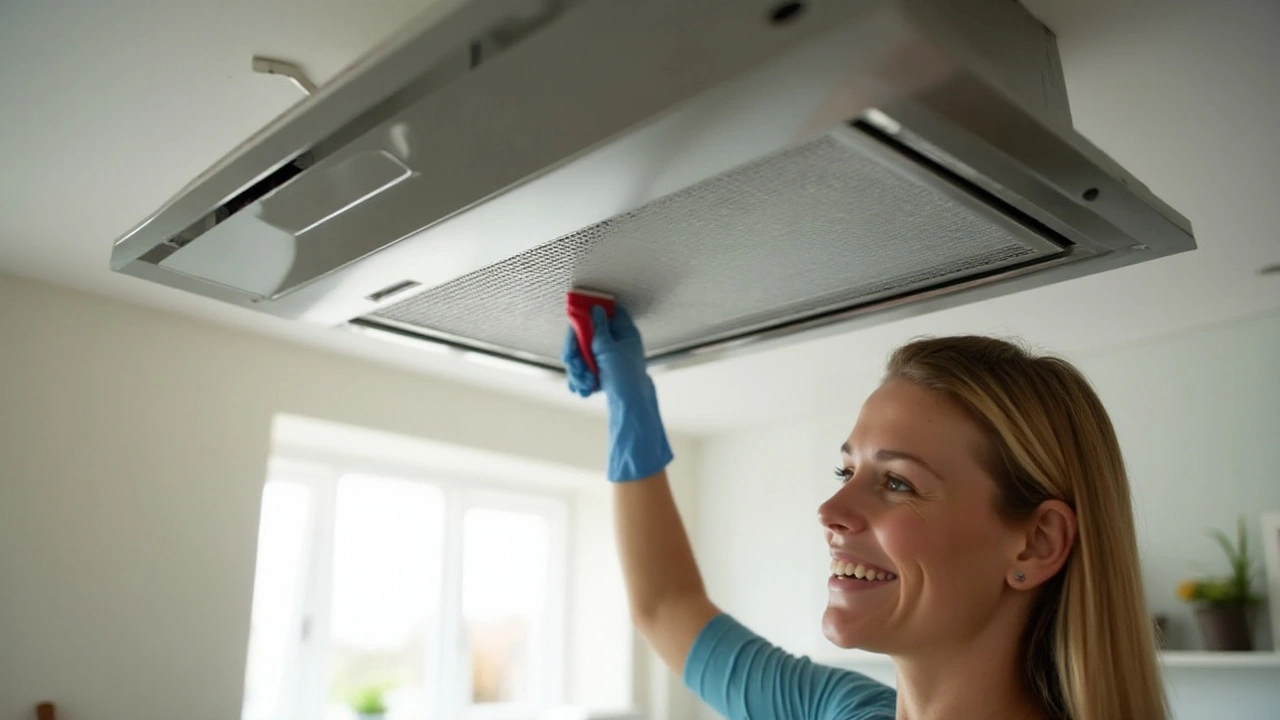Extractor fans often go unnoticed, silently guarding the quality of air in our homes and workplaces. However, like any other household appliance, they require regular attention and care to function effectively. In this article, we dive into the world of extractor fan maintenance, focusing on why it should never be overlooked.
Imagine a friend always watching your back, ensuring every breath you take is fresh and pure. That’s what an extractor fan does, tirelessly working to remove smoke, moisture, and odors from your indoor spaces. Yet, many of us forget that even the most dependable helpers need some help. By understanding how and when to service your extractor fan, you can extend its life and keep your environment inviting and clean.
- Understanding Extractor Fans
- Signs Your Fan Needs Servicing
- Steps for Regular Maintenance
- Benefits of Professional Servicing
- DIY vs. Professional Repairs
Understanding Extractor Fans
Extractor fans have become a staple in modern homes, playing a quiet yet pivotal role in maintaining good air quality. These devices are designed to remove moisture, smoke, and odors from indoor environments, which is essential to prevent mold growth and keep your living space pleasant and healthy. Despite their unassuming presence, extractor fans are marvels of engineering, capable of making a significant difference in your home's ventilation system.
At the core of an extractor fan's operation is its ability to effectively draw air out of a room and expel it outside. This process helps to maintain a constant flow of fresh air by reducing humidity and ensuring contaminants are efficiently removed. The heart of any extractor fan is its motor, which powers the blades or impeller that moves air. These motors come in various power ratings, directly influencing the fan's efficiency in removing unwanted air.
The placement of extractor fans is just as crucial as their function. They are commonly found in kitchens and bathrooms, areas recognized for producing excess moisture and heat. In kitchens, these fans capture cooking odors, smoke, and grease, contributing to a cleaner and fresher environment. Meanwhile, in bathrooms, they prevent condensation and reduce the potential for mildew, enhancing the overall hygiene of the household. These fans are typically rated in cubic feet per minute (CFM), measuring the volume of air they can move within a minute. A suitable CFM rating ensures optimal performance, keeping rooms free from dampness and odor.
Did you ever wonder, 'How important are extractor fan servicing intervals?' Regular servicing is critically important for maintaining these fans. Like any appliance, extractor fans can suffer from wear and tear over time. Dust and grime can clog the fan blades, making it harder to operate efficiently, which can, in turn, increase energy consumption and decrease lifespan. Servicing can involve cleaning, lubrication, and sometimes replacing components to ensure longevity and efficiency.
According to an HVAC industry report, "Regular maintenance of ventilation equipment can extend the device's lifespan by up to 10 years and improve efficiency by up to 25%." Ensuring that these systems are up to par not only saves on electricity costs but also contributes to a more sustainable environment by reducing energy waste.
The best part is that modern extractor fans are equipped with various features to enhance convenience and performance. Some models include humidity sensors, which activate the fan when moisture levels rise, ensuring your space stays dry no matter how steamy things get. Others come with timers, allowing the fan to continue operating for a set period after you leave the room, guaranteeing a complete and thorough ventilation cycle.
Signs Your Fan Needs Servicing
An extractor fan might seldom be the topic of dinner conversation, but it certainly plays a crucial role in our homes. As with any piece of machinery, being aware of when the fan is crying for help is pivotal to ensuring its longevity and performance. Let's explore some of the indicators which suggest your extractor fan might need a check-up.
One of the most glaring signs is unusual noise. An extractor fan operates inconspicuously, blending into the background without drawing much attention. However, when it begins to function inefficiently, unusual grinding or rattling sounds might emerge, indicating potential problems such as dust accumulation or a misaligned fan blade. The extra noise might be your fan's way of begging you to investigate its innards. Swiftly addressing these auditory clues can save you from an expensive repair or replacement.
Another symptom that shouldn't be ignored is a noticeable decline in the fan’s performance. If you find that rooms remain persistently steamy after showers or cooking odors linger longer than usual, these could be signs that the fan's motor is weakening or its ducts are obstructed. Reduced efficiency often hints at either electrical issues or a more mechanical problem such as a clogged filter, which is crucial in maintaining an effective ventilation process.
"Many homeowners unknowingly allow their fans to run subpar due to lack of maintenance, ultimately compromising indoor air quality," observes John Walker, an expert technician with over 20 years of experience. His insights stress the importance of regular checks, especially if your home shows visible signs of moisture on walls, which might hint at a failing fan.
Mold and mildew buildup around the fan area can serve as another red flag that demands attention. These uninvited guests often thrive in damp environments, which might be created when a faulty fan can't remove moisture effectively. If left unchecked, the growth might pose health risks, such as allergies or respiratory issues. Therefore, ensuring your fan's filters are clean and the air-passageways are unobstructed becomes crucial.
Occasionally, it's beneficial to give your fan a literal smell test. A lingering burnt odor when the fan is running could mean essential components are overheating or wires are melting due to electrical overloads. This isn’t just a signal of wear and tear but could also pose a significant fire hazard if ignored. Scheduled maintenance is essential in nipping such dangerous possibilities in the bud.
It's worth noting that modern fans often come with built-in indicators like LED lights or notification alerts. These advanced models might have self-diagnosing capabilities, alerting homeowners when it’s time for maintenance. Reviewing your fan’s user manual can provide insights into these features, helping you stay on top of potential problems before these become severe issues.

Steps for Regular Maintenance
Maintaining an extractor fan properly is like keeping a treasured heirloom clean and polished. It doesn’t just prolong the life of your appliance but ensures it performs at its peak efficiency. Many people overlook this part of home maintenance, not realizing the wealth of benefits it brings. An essential first step is to turn off the power supply to the fan, ensuring safety as you proceed with any maintenance task. Safety trumpets all when undertaking any form of technical upkeep.
Once that’s settled, it’s time to look at the grill or cover. Dust and grease can accumulate, hindering the fan’s ability to do its job. Remove the grill if possible and soak it in warm soapy water, scrubbing gently with a brush to get rid of the grime. Allow it to dry thoroughly before replacing it. This simple action can keep unpleasant odors at bay and improve airflow, helping your ventilation system work more effectively. While you're at it, take a flashlight to peek inside the fan housing.
Inside you might find dust bunnies and cobwebs lurking. Use a vacuum cleaner with a long nozzle to suck these out, taking care to reach into the crevices. Some folks recommend using a damp cloth to wipe down the blades, mixed with a bit of mild detergent. When you do this, it’s best to be gentle, as a heavy hand could knock them out of alignment. Regular cleaning like this is often overlooked but can drastically increase the fan's longevity.
Inspecting for Wear and Tear
Now, let's talk inspection. Periodically, checking components like the fan’s wiring is crucial. Frays or damages here can lead to unnecessary hazards. If you spot any issues, it might be time to call a professional. Similarly, listen for any unusual sounds when the fan operates. A gentle hum is normal, but rattles and clanks might suggest a problem that needs attention. As famous inventor Thomas Edison once said,“Good fortune is what happens when opportunity meets with planning.”Paying attention to these details can prevent major problems from developing over time.
Effective extractor fan servicing also involves occasional oiling of the fan's motor bearings, where applicable. This ensures the fan operates smoothly without hindrance. Be sure to use the lubricant recommended by the manufacturer to avoid voiding any warranty or complicating repairs. Lastly, always remember to test the fan after maintenance to verify everything is running smoothly. Hold your hand up to the fan when it is running; if you don’t feel strong suction, you may need to investigate further or reassemble components carefully.
Benefits of Professional Servicing
Servicing your extractor fan with the help of professionals can significantly enhance its performance and longevity. When experts examine your fan, they check components that are often missed during casual cleaning or DIY maintenance. This can include deep-cleaning the fan's blades, motor, and ductwork, all areas where dust and grime love to hide and accumulate. Over time, these buildups can strain the motor, leading to reduced efficiency and even complete system failure. By ensuring every part of your fan is in top shape, professionals help preserve its energy efficiency, potentially saving you money on electricity bills.
Beyond cleaning, professionals often offer diagnostic services that identify technical faults before they become critical. For instance, they can uncover electrical issues or motor inconsistencies that might cause noisier operation or unexpected shutdowns. Ventilation systems are more complex than they appear, and having trained eyes spot these problems early can prevent costly repairs or replacements. From recalibrating controls to ensuring optimum airflow, a professional touch makes all the difference in maintaining smooth operation. In the long run, this proactive approach can save homeowners not only financial costs but also the headaches of dealing with sudden breakdowns.
Extractor fan repair experts also bring specialized tools and products to the job, ensuring thorough and safe maintenance. Often, these tools are beyond the reach of an average homeowner, who might not know how to disassemble and reassemble the fan correctly without causing further damage. The use of correct lubricants, appropriate cleaning agents, and specialized vacuum systems can restore a fan to near-original condition. There’s something to be said about the peace of mind that comes with knowing your fan won't disrupt your daily activities with unexpected rattling or reduced suction.
"In most households, proper servicing of ventilation systems is often skipped," explains Mike Thompson, a leading HVAC specialist. "Scheduling regular check-ups with professionals ensures powerful extraction and can make your home a healthier place to live."
Lastly, by opting for professional servicing, you also gain valuable guidance on system upgrades or replacements. As technology advances, newer models of extractor fans hit the market, boasting features like increased energy efficiency, quieter operation, and even smart home integration. Experts can provide suggestions tailored to your household's needs, helping you decide whether it's time for an upgrade or if your current model still fits the bill. With their broader industry knowledge, they can offer options and solutions that aren’t merely repairs but meaningful improvements to your living space.
From extending the life of your system to enhancing the air quality in your home, the benefits of professional servicing are numerous. Not only do you get the advantage of technical expertise and sophisticated tools, but you also ensure that your ventilation upkeep is a priority, contributing to comfort and health in your home. Taking the time to engage professional services is a worthwhile investment in the sustainable functionality of your extractor fan.

DIY vs. Professional Repairs
When it comes to maintaining your extractor fan, the decision between handling repairs yourself or calling in a pro can make a significant impact. While DIY enthusiasts take pride in their handiwork, confident in an ever-expanding arsenal of YouTube tutorials and online guides, there remains a distinct advantage to hiring a skilled technician. Start with noting that a proficient repair job often lies in experience, and knowing an extractor fan like the back of their hand is the forte of professionals.
The allure of a DIY solution largely hinges on the potential savings and satisfaction of fixing something on your own. When budgets are tight, it’s tempting to tackle minor issues personally. Performing simple tasks like cleaning the vents or replacing a filter can usually be done with minimal tools and guidance from the manufacturer's manual. Yet, when complex electrical repairs or unexplained clunks and clatters come into play, the stakes are remarkably higher.
It's crucial to acknowledge that a misstep while working with electrical components can pose severe safety risks, not just for you but for the entire household. According to a survey by the National Fire Protection Association, electrical failures or malfunctions were factors in an estimated 44,880 home fires per year. When faced with such a statistic, one might reconsider DIY repairs unless possessing substantial electrical experience.
Calling in the Experts
In contrast, a professional brings not only skill but diagnostic equipment that can identify and solve issues swiftly. Engaging an expert ensures that the extractor fan servicing is thorough, reducing the likelihood of recurring issues. Professionals also stay updated with the latest industry standards and safety regulations, offering peace of mind that a seemingly minor fault won't spiral into an expensive catastrophe later.
A report from HVAC industry observers highlighted that homeowners frequently underestimate the complexity hidden within these ventilation systems. On one hand, minor misjudgments might seem inconsequential, yet they can cascade into bigger problems if left unresolved. "It's often surprising what hides beyond the grille. Completing a comprehensive service exposes buildup and minor defects that might escalate," says Martha Jenkins, an HVAC specialist with two decades of experience.
For those who find themselves torn between the options, it may be helpful to weigh both the cost of professional repairs against potential risks and the long-term benefits. Thanks to various online platforms, obtaining quotes and assessing reputation through customer reviews is now more accessible than ever. Bear in mind that while professionals carry a fee, they often extend warranties or guarantees that promise reliable performance.
Comparing Costs and Benefits
When evaluating the cost of professional services versus DIY, it's worth drawing up a side-by-side comparison to understand the practical implications. Consider aligning the costs of purchasing necessary tools and replacement parts as a non-specialist against the potentially minimal outlay of a professional fix, often completed in a shorter time frame.
- DIY Benefits: Cost-effective for minor repairs, no scheduling hassle.
- Professional Benefits: Expertise in diagnostics, safety assurance, reliability.
Ultimately, the choice remains a personal one—what suits your circumstances and comfort level. Whether you're driven by the thrill of a hands-on project or prudently opting for a professional touch, ensuring the health of your ventilation upkeep is vital for maintaining a pleasant home environment.




